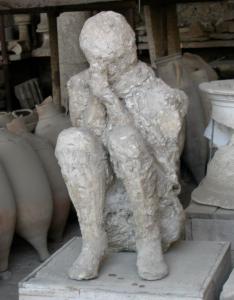
|
Early "archeologists" were really just treasure hunters. In 1860 Giuseppe Fiorelli was appointed to take charge of the excavations at Pompeii. He introduced the first truly scientific approach to discover what knowledge was buried at Pompeii. In 1863 Fiorelli developed the ingenious technique of making plaster casts of the remains of people, animals, and plants. The outlines of clothing, sandals, hair, and facial expressions were often reproduced in astonishing detail. With plaster casts now scattered about the ancient city, we can observe the images of Pompeians as they died. Most tourists find these casts both macabre and enjoyable.
It is still true today, as J. W. Goethe (1749-1832) wrote about Pompeii, "Many a calamity has happened in the world, but never one that has caused so much entertainment to posterity as this one." People's interest in the sinking of the Titanic in 1912 comes to mind as a modern example of society's fascination with how people react when they recognize that their own death is imminent. |
